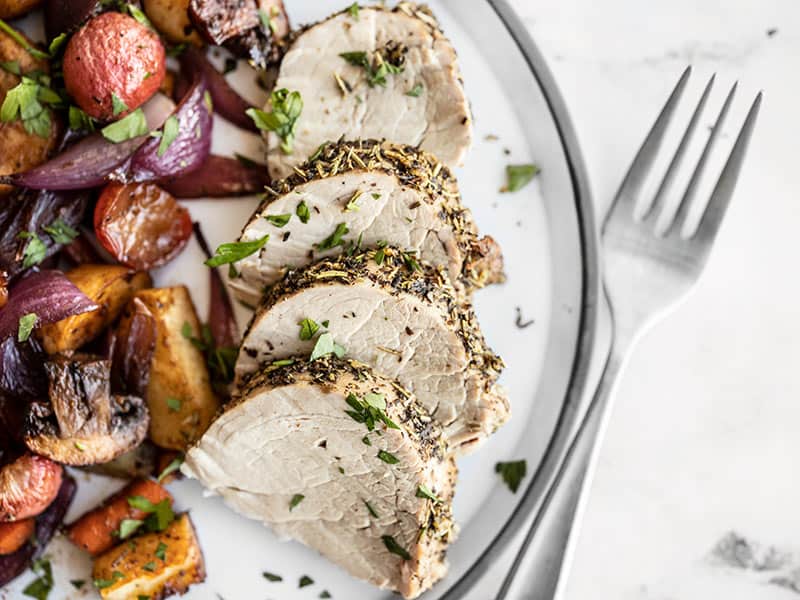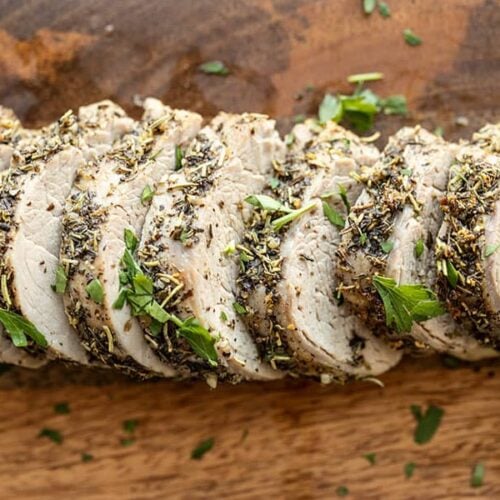You can use this Herb Roasted Pork Tenderloin recipe if you aren’t very good in the kitchen but still want to make someone happy. It’s ridiculously simple and pretty much fool proof. Spread garlic, herbs, and oil on the pork, then put it in the oven. THE END. It’s really that easy.
Pork is a remarkably versatile meat that takes well to a wide variety of seasonings. While salt and pepper are classics herbs and spices can truly bring pork dishes to life. The key is understanding which herbs and spices best complement pork’s flavor profile.
Certain herbs contain robust, woodsy notes that pair perfectly with pork’s rich umami. Likewise, spices can punctuate pork with tangy, spicy or warm flavors. Using the right combinations in marinades, rubs, sauces and more allows you to accentuate pork’s natural flavors.
Let’s explore some of the top herbs and spices for pork and how to use them for maximum impact,
Herbs That Shine with Pork
Herbs offer a fresh, garden-grown flavor that excels at bringing out pork’s savory qualities. Here are some top choices:
-
Rosemary – This intensely pine-flavored herb is a natural with pork. Use chopped rosemary in marinades or rubs for roast pork or chops.
-
Thyme – Subtler than rosemary, thyme still has an earthy flavor. It shines in pork stews or when rubbed on tenderloin.
-
Sage – Sage’s woodsy, slightly minty notes pair beautifully with pork sausage, chops and roasts. Use it dried or fresh.
-
Oregano – Oregano’s zesty, aromatic flavor livens up pork. Sprinkle on top of cooked pork or blend into marinades.
-
Marjoram – This herb tastes like a milder oregano It excellently seasons rich cuts like shoulder or ribs
-
Parsley – Fresh parsley brightens up pork with its light peppery taste. Use it as a garnish or in stuffing.
-
Tarragon – Tarragon’s licorice-anise flavor complements pork’s fattiness. Feature it in pan sauces for pork medallions.
-
Basil – Sweet basil balances pork’s richness. Make pesto for grilled pork or stir into pasta sauce with Italian sausage.
Spices to Enhance Pork’s Flavor
Warm spices like cumin, coriander and mustard seeds also pair wonderfully with pork. Consider these spicy ideas:
-
Caraway Seeds – These distinctive seeds infuse pork with a dill-like flavor. Add to sauerkraut and roasted pork.
-
Fennel Seeds – The subtle anise taste of fennel seeds offsets pork’s meaty flavor. Use in sausage or ground pork.
-
Cumin – Earthy cumin packs a punch. Rub pork shoulder with cumin, garlic and oregano before roasting.
-
Coriander – Toasty coriander balances and rounds out spice mixes for pork. It shines with cumin and chili powder.
-
Mustard Seeds – Mustard seeds lend pork a peppy spiciness. Try them in marinades, or use ground mustard in a glaze.
-
Cloves – Used sparingly, cloves add a touch of warmth. Stick one or two in the ham before cooking.
-
Chili Powder – For Southwestern flair, coat pork shoulder with chili powder, cumin, garlic and lime before grilling.
-
Curry Powder – Curry’s blend of spices like turmeric and coriander jazz up plain pork chops. Quickly sauté and serve over rice.
Tips for Using Herbs and Spices on Pork
Now that you know which herbs and spices to use, here are some tips for maximizing their impact:
-
Shop for fresh herbs when possible – their flavor really shines through. For dried, buy smaller quantities to retain potency.
-
Rub herb/spice mixtures directly onto pork at least 30 minutes before cooking. This infuses major flavor.
-
When using dried spices, briefly toast them in a dry pan before grinding. This intensifies their taste.
-
Don’t overdo it with strong herbs like rosemary. A little goes a long way.
-
Add woody herbs like thyme and rosemary early in braises and stews. More delicate herbs go in later.
-
Garnish finished pork dishes with fresh herbs like parsley, basil or cilantro. This adds a final punch of herbaceous flavor.
With this guide to complementing herbs and spices, you can make your pork dishes burst with flavor. Have fun playing with different herb and spice blends to find new favorites!

What Cut of Pork is Best for This Recipe?
This recipe was first made with a smaller piece of pork loin, but I’ve changed it so that pork tenderloin is used instead. Although they have similar names, they’re actually two different muscles and are quite different. Pork loins are quite large and a bit more tough than the small, delicate tenderloin muscle. I definitely prefer the pork tenderloin for this recipe. If you do happen to use a pork loin, be aware that if it is larger than 1. 5 lbs. , which most are, it will require a longer cook time (and probably more herb rub).
Pork tenderloins are often sold in packs of two. You can either double this recipe and freeze one tenderloin for another time you want to make this for dinner. Just make sure the two cuts of meat don’t make the dish too crowded.


- 2 cloves garlic ($0.16)
- 1 tsp dried basil ($0.10)
- 1 tsp dried thyme ($0.10)
- 1 tsp dried rosemary ($0.10)
- freshly cracked black pepper ($0.05)
- 1/2 tsp salt ($0.02)
- 2 Tbsp olive oil ($0.32)
- 1.33 lbs. pork tenderloin ($4.68)
- Preheat the oven to 400ºF. Mince the garlic. Put the rosemary, thyme, and dried basil in a small dish. Use your hands to crush the dried rosemary slightly. Garlic, olive oil, salt, and freshly ground black pepper should all be added to the bowl and mixed together.
- Put the pork tenderloin on a baking dish or sheet. The oil and herb mix should be rubbed all over the pork, even the bottom.
- The oven should already be hot when you put the baking dish in it. Roast the pork for about 35 minutes, or until the internal temperature reaches at least 145ºF. Let the pork rest for 10 minutes at room temperature before cutting it up and serving it.
What Herbs Go Best with Pork?
Like chicken, pork is a mild meat that goes well with a lot of different herbs and spices. The mix I used in this recipe is a classic one: basil, thyme, and rosemary. It can be used to season chicken, beef, or any other kind of meat. I put some black pepper and garlic in the mix to make it stand out. You can even add some crushed red pepper if you want to take it to the next level.
Salt is also a very important component of the seasoning for this pork. But if you don’t add the right amount of salt, you won’t be able to fully taste the herbs. So don’t skip the salt!.
Herbs and Spices for Beginners | How to use Herbs and Spices | Vil and Zoe’s Galley
FAQ
What spices pair well with pork?
How do you spice up bland pork?
What spices tenderize pork?
What spices go well with pork?
Warm, woody, and a bit floral, cinnamon is one of those spices that go well with pork. It can be used in both sweet and savory dishes, making it a versatile ingredient to have on hand. When paired with pork, cinnamon can help to balance out the richness of the meat and add a touch of sweetness.
Is Sage a good herb for pork?
Sage is an herb that is commonly used in pork dishes. It has a strong, savory flavor that is slightly minty and slightly bitter. Sage is a good herb to use with a fatty cut of pork, because it helps to cut through the fatty flavor and enhance the flavor of the meat. There are several ways to use sage when cooking pork.
What herbs go well with pork chops?
Some of the best herbs to use when cooking pork chops include rosemary, thyme, sage, and oregano. These herbs are all relatively robust and have flavors that pair well with the rich, savory taste of pork. Pork chops are often grilled, pan-fried, or baked.
What herbs should I use to make pork tenderloin?
Similarly, some herbs, like rosemary, have a strong flavor that can easily overwhelm a dish. Others, like thyme, have a more delicate flavor that can be easily lost in a dish. To maximize the flavor of these herbs, it is best to use fresh herbs if possible. However, dried herbs can also be used and will add flavor to the pork.
